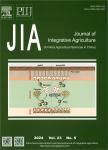Influence of Climate and Socio-Economic Factors on the Spatio-Temporal Variability of Soil Organic Matter: A Case Study of Central Heilongjiang Province, China
Influence of Climate and Socio-Economic Factors on the Spatio-Temporal Variability of Soil Organic Matter: A Case Study of Central Heilongjiang Province, China作者机构:School of Management Tianjin Polytechnic University Key Laboratory of Agri-Informatics Ministry of Agriculture/Institute of Agricultural Resources & Regional Planning Chinese Academy of Agricultural Sciences College of Management Tianjin University
出 版 物:《Journal of Integrative Agriculture》 (农业科学学报(英文版))
年 卷 期:2014年第13卷第7期
页 面:1486-1500页
核心收录:
学科分类:0710[理学-生物学] 0832[工学-食品科学与工程(可授工学、农学学位)] 0830[工学-环境科学与工程(可授工学、理学、农学学位)] 1004[医学-公共卫生与预防医学(可授医学、理学学位)] 0905[农学-畜牧学] 09[农学] 0906[农学-兽医学] 0903[农学-农业资源与环境] 0901[农学-作物学] 0703[理学-化学] 0902[农学-园艺学] 0713[理学-生态学]
基 金:financed by the National Basic Research Program of China(2010CB951502) the National Natural Science Foundation of China(41101537,40930101,41201184 and 71203157)
主 题:soil organic matter climate socio-economic factors GWR Heilongjiang Province
摘 要:For the scientific management of farmland, it is significant to understand the spatio-temporal variability of soil organic matter and to study the influences of related factors. Using geostatistical theory, GIS spatial analysis, trend analysis and a Geographically Weighted Regression (GWR) model, this study analyzed the response of soil organic matter to climate and socio-economic factors in central Heilongjiang Province during the past 25 years. Second soil survey data of China for 1979-1985, 2005 field sampling data, climate observations and socio-economic data for 1980-2005 were analyzed. First, soil organic matter in 2005 was spatially interpolated using the Co-Kriging method along with auxiliary data sets of soil type and pH. The spatio-temporal variability was then studied by comparison with the 1980s second soil census data. Next, the temporal trends in climate and socio-economic factors over the past 25 years were investigated. Finally, we examined the variation of the response of soil organic matter to climate and socio-economic factors using the GWR model spatially and temporally. The model showed that 53.82% area of the organic matter content remained constant and 29.39% has decreased during the past 25 years. The impact of precipitation on organic matter content is mainly negative, with increasing absolute values of the regression coefficient. The absolute value of regression coefficient of annual average temperature has decreased, and more areas are now under its negative effects. In addition, the areas of positive regression coefficient of annual sunshine hours have northward shifted, with the increasing absolute value of positive coefficient and decreasing absolute value of negative coefficient. The areas of positive regression coefficient of mechanized farming as a socio-economic factor have westward shifted, with the increasing absolute value of negative coefficient and decreasing absolute value of positive coefficient. The area of regions with the positive regression coefficient of irrigation has expanded. The regions with positive regression coefficient of fertilizer use have shrinked. The positive regression coefficient of mulch film consumption has significantly increased. The regression coefficient of pesticide consumption was mainly positive in the west of the study area, while it was negative to the east. Generally, GWR model is capable to investigate the influence of both climatic and socio-economic factors, avoided the insufficiency of other research based on the single perspective of climatic or socio-economic factors. Therefore, we can conclude that GWR model could provide methodological support for global change research and serve as basic reference for cultivated land quality improvement and agricultural decision making.



